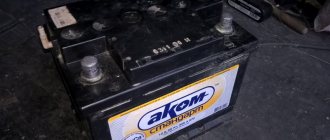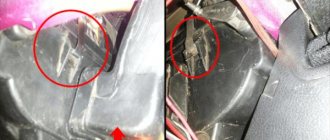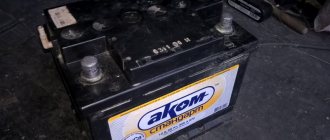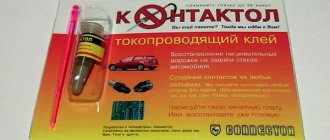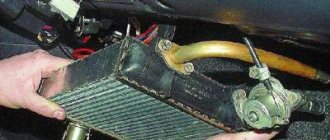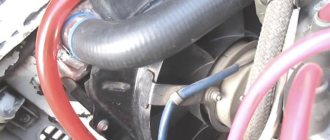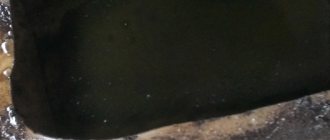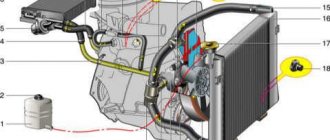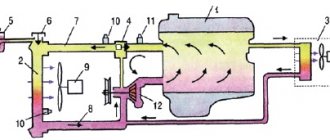Before dismantling
In any car, including the Lada Kalina, replacing the cooling radiator implies that all the antifreeze has been drained from the system. How exactly you can get rid of old antifreeze was discussed in detail earlier. Well, now let us note once again that any manipulations can be performed after disconnecting the battery. It’s easier to unscrew and remove the “negative” terminal, which is what is done in practice.
It turns out that you first need to open the hood and disconnect the terminal, and only then can you proceed with subsequent operations. One of them will be removing the antifreeze, the other will be dismantling the fan.
Look again at exactly what the unit called “radiator” looks like. Before dismantling it, it is necessary to remove the fan with the casing.
The main thing is not to forget to disconnect the electrical connector. Also, you need to disconnect the pipes (two large and one thin). Of course, all this is done when there is no longer any antifreeze.
Tighten the battery terminal with a 10mm wrench
Owners of cars with 8-valve engines are a little luckier than everyone else. For them there is no need to remove the decorative trim that limits access to the engine. The plastic cover must be completely removed:
- Having pressed the latch lever, disconnect the wire loop from the connector of the adsorber purge valve;
- The metal plate fixing the valve is pryed with a screwdriver and removed;
- The valve module, together with the attached hoses, is moved to the side;
- You need to unscrew the oil filler plug;
- The cover is dismantled as follows: by carefully pulling the part up, it is disconnected along with the fasteners.
The actions listed in the list are illustrated in the photo.
Preparation and replacement algorithm
Equipment and related tools:
- Cap, carob, head size “10”;
- Medium length Phillips screwdriver;
- Container for draining waste and reagent residues;
- Pliers with thin teeth at the ends.
- Drive the car onto a viewing hole or overpass;
- Allow the engine and coolant to cool as well;
- Place a container under the radiator drain valve;
- Open the top cap of the expansion tank, tap and start draining;
- Using a screwdriver, unscrew the four bolts that secure the cooler to the polymer frame;
- Having slightly loosened the clamps on the upper and lower pipes, disconnect them from the metal sleeves;
- Disconnect the band clamp and hose connecting the expansion tank and radiator. You must be careful, as residual antifreeze may leak out;
Using a cape or socket, unscrew the two bolts securing the radiator to the car body; By tilting it slightly towards the inside of the engine, we begin to release the radiator; We remove the two rubber mounting pads and simultaneously carry out their diagnostics. If necessary, we make a replacement; We clean the outer and inner shell of the product with a jet of water to remove unwanted deposits or insect residues that can cause poor circulation and cooling; We check for leaks by artificially plugging the outlet holes, except for one through which we supply air under pressure; Place it in a container of water and wait about 30 seconds. Air bubbles will indicate a leak; We mark the area with chalk and send it for sealing; Instead of the old one, we put a new one and assemble it in the reverse order; Fill in coolant, preferably new;
In terms of time, replacing the cooling radiator on Kalina can take no more than 30 minutes of pure work, not counting the time for cooling the car. In this way, you, as a driver, have gained invaluable experience and saved money that would have been spent on paying for services at a service station. And after soldering, the old radiator can be neatly folded in the garage, having previously packed all the holes from insects and bugs, until the next need.
| Is the cooling fan turning on too often or is the car overheating? One of the reasons is a dirty cooling radiator, which can no longer perform its duties 100%. Do you know how to remove the Lada Kalina/Granta engine radiator with your own hands? |
You will need: remove the radiator fan, drain the antifreeze, prepare a “10” wrench (preferably a socket head), a Phillips screwdriver and pliers with long thin jaws.
Procedure for removing the engine radiator:
- Move the clamp, squeezing the hose fastening antennae.
- Remove the hose from the radiator fitting.
- Move the clamp of the supply hose to the radiator, squeezing the antennae.
- Remove the hose from the radiator pipe.
- In the same way, disconnect the outlet hose from the radiator.
- Unscrew the two upper radiator mounting nuts.
- Remove the nuts and washers.
- Remove the radiator from the car by tilting it towards the engine.
Installation of the cooling radiator is carried out in the reverse order, having previously replaced the two lower mounting cushions and the rubber-metal bushings of the upper radiator mountings.
For reference: currently the price of the Granta radiator with catalog number 21900-1301012-01 is 4200 rubles. And the Kalina radiator 11180-1301012-00 costs 1500 rubles.
By the way, in order to extend the service life, it is recommended to install a radiator grille (on Granta or Kalina and Kalina 2).
How to remove a radiator (step by step instructions)
Let's assume the following requirements are met:
- The negative terminal is disconnected;
- There is no antifreeze in the cooling system;
- The 16-valve engine trim was removed.
Then, you can begin to dismantle the fan cooling the radiator. It may be necessary to remove the air filter module, which prevents free access to the engine compartment. The module is not completely dismantled, but simply taken to the side. Then you can remove the fan:
- Disconnect the fan power connector;
- Unscrew two metric 10 located on top of the casing;
- The same bolt is located below. It needs to be unscrewed with a spanner;
- The fan casing must be carefully guided upward (along the guide on the radiator), then disengaging the plastic tab.
What is this?
By car radiator, craftsmen mean a device that removes excess heat from the engine. This part is part of the cooling system. In most cases, its failure completely disables the entire cooling system and contributes to engine overheating.
The unit consists of the following basic elements:
The essence of the malfunction may be:
- Core clogged.
- Depressurization of the tank.
- Contamination of the external surface of the spare part.
If the breakdown is minor, it can be eliminated by replacing individual parts. But if most of the radiator elements are faulty, then it is better to buy a new set. And, as practice shows, restored old radiators often break down after a short time.
A malfunction in the cooling system unit can be guessed by the following signs:
- The engine constantly overheats.
- The motor does not turn on.
- The engine is overcooled.
- There is a coolant leak.
We remove air from the cooling system (example in the video, engine 21116)
The radiator should be replaced if you find a fluid leak in your Lada Kalina 2. The radiator can be inspected and repaired in specialized services.
Take a 10mm wrench, a Phillips screwdriver, and a clamp with elongated thin jaws.
Warning
Carry out the removal procedure only on a cold engine.
2. On vehicles with air conditioning, unfasten the front bumper.
Note
The front bumper is disconnected because when removing the radiator of the cooling structure, it is also necessary to remove the condenser of the air conditioning structure. Because of the bumper, this procedure will become inaccessible as it blocks access.
3. Remove the electric radiator fan.
4. Squeeze the antennae of the breather fastening clamp, move the clamp along the breather,
5. Disconnect the breather and radiator fitting.
6. Squeeze the tendrils of the inlet breather fastening tie towards the radiator and slide the tie along the hose.
7. Remove the breather from the radiator pipe.
8. In the same way, disconnect the outlet breather and radiator.
9. On vehicles equipped with an air conditioning structure, disconnect the radiator of the cooling structure and the condenser of the air conditioning system. DO NOT disconnect the condenser and piping. Secure the condenser to the radiator frame.
Warning
Be careful when disconnecting the condenser from the air conditioner. Take it to the required distance so as not to damage the pipelines of the air conditioning structure.
10. Unscrew the 2nd fastening nuts to the upper cross member of the radiator frame,
11. Remove the nuts secured under the washer nuts,
12. Tilt the radiator towards the engine,
13. Remove the radiator from the engine compartment of Lada Viburnum 2.
14. Remove the 2nd lower fastening pads from the radiator, if any remain on the radiator mounting pins. If the cushions remain on the body, remove them from the lower cross member of the radiator frame.
Replacing the radiator Lada Kalina 1st generation
Cleaning the car air conditioner radiator
The repair procedure is as follows.
Prepare the required materials: a Phillips screwdriver, 10-mm sockets and open-end wrenches, a container for draining the waste. The machine is thoroughly washed and left in the inspection pit to cool the power plant.
When performing repairs, care must be taken - even small debris should not enter the cooling system. After the car has cooled, drain the waste into a previously prepared canister. Initially, the cover of the radiator and radiator opens, then the drain opens and the liquid flows on its own to where it is directed. Loosen the clamp securing the upper pipe and remove it
The lower hose is unscrewed in the same way.
Next, you will need to release the seal of the expansion tank and radiator. Using pliers, loosen the plastic clamp and pull the thin hose off the tube flange. The next step is to remove the radiator itself. Using wrench No. 10, unscrew the two screws securing the part to the car body.
Tilt the radiator approximately 10-15 cm towards the engine and pull it up. After this, the part should easily separate from the machine.
If plastic fasteners are stuck at the bottom of the device, they need to be removed and moved to the body brackets.
When installing it back, there is no need to replace the lower cross member of the Lada Kalina radiator frame - the part is put back in place in the reverse order. But for convenience, the operation can be performed.
Fundamentally, replacing the radiator of a 2nd generation Lada Kalina is practically no different from the procedure performed on a car of the first modification. The main difference is only the need to first remove the plastic engine cover.
Subscribe to news
KUZOV magazine is one of the Russian auto magazines for professionals in the auto repair business. On its pages you can find the information you are interested in on all aspects of the activities of auto repair enterprises, body technologies, methods of painting and preparing various types of car surfaces, information on paint and varnish and other consumables, auto service equipment, as well as learn about the latest trends in the modern automotive market.
Today, due to the fact that automobile sites have begun to appear more and more often on the Internet, Russian auto magazines have also become very popular among enthusiasts. And it is often so difficult to find among all these online notes something worthwhile that at any moment will help you not only find all the necessary information, but also become a real guide in the world of cars.
Agree, if you own a car, then it is so important for you, more than anyone else, to know everything about your car. You can learn about all the nuances of the work and pitfalls from our magazine.
Our specialists also conduct regular visits to events and conferences related to both new cars and retro cars.
We invite sophisticated car enthusiasts to pay attention to the business side of the issue - the auto business. How is the training of car service personnel currently taking place, what new capabilities do modern car mechanics have. We will help you not to make a mistake and choose the most correct car service. We tried to highlight all the most important and interesting things from the world of cars. After all, every car enthusiast is interested not only in, for example, the technology for removing dents from his car, but also in what new products in the auto business are currently relevant.
In the “Press Center” section you can find the latest news and both current and future events from the world of the auto business. In the Season Premieres section there is a selection of the most anticipated new products on the automotive market. The most interesting shots from various automotive events are in the Photo Gallery section. Repair work can be seen in action in the Video section.
The publication has been known in the professional print media market for more than 8 years. Intended for automotive market professionals, it talks not only about the most current news and problems of the industry, but also offers ways to solve them based on the experience of active participants in this market segment.
Wide advertising opportunities are provided by the magazine’s clearly defined target audience, the optimal structure of its distribution in Russia and the CIS countries, as well as professional editorial content and high quality printing.
Thanks to the versatile and non-standard advertising formats used in the magazine, as well as thoughtful information support for the advertising campaign, maximum positioning of the advertiser’s brand, products, services and solutions among its potential clients is achieved.
Types of parts
All radiators are classified into the following types:
- Oil (maintains normal operating temperature of the oil in the engine compartment).
- Liquid (liquid enters the circuit and cools the cylinder thanks to the pump).
Depending on the material used, there are spare parts:
The latter are rarely found on sale today. Copper ones are considered the highest quality and are more suitable for the Kalina car. But their cost is the highest.
Radiators are also distinguished:
- With oval tubes (characterized by good heat dissipation and durability).
- With round tubes (their heat transfer is limited, they are cheap).
- Sintered (wear-resistant and reliable).
Depending on the year of manufacture and Kalina index, there are radiators for:
Radiators sold according to condition:
- Old ones that have not been renovated.
- New.
- Used and refurbished.
Auto parts are classified according to their originality:
According to the manufacturer, non-original spare parts can be of the following brands:
- Fenox (Belarus).
- Valeo (France).
- Nissens (Denmark).
- Luzar (Russia).
- Behr Hella (Germany).
- AVA Quality Cooling (Germany).
You can pick up a radiator for Kalina at the place of purchase:
ODS device of Lada Kalina
Kalina 1 and Kalina 2 cars use a liquid cooling system. It consists of an engine jacket, radiator, electric fan, pump (water pump), expansion tank, thermostat and connecting hoses. The coolant moves through two circulation circuits. In a small circle, antifreeze circulates only through the engine jacket, while in a large circle, the liquid passes through the radiator.
Expansion tank
Used to pour liquid into the system. It is made of heat-resistant plastic of a translucent color to allow you to control the level of antifreeze. There is a special pipe on the top through which the tank is connected to the radiator steam outlet.
The tightness of the entire system is ensured by the valve cover, which has inlet and outlet valves. The latter is designed to maintain pressure in the SOD above atmospheric pressure. Due to this, losses in the form of steam are reduced, and the boiling point of the working fluid increases. The exhaust valve of the cover opens when the pressure rises to 1.1 bar, and the inlet valve opens when the pressure drops to 0.13 bar and the engine cools down.
water pump
This is a centrifugal pump with blades. It is belt driven from a crankshaft pulley and is included in the gas distribution system. The pump is made of aluminum. This unit cannot be repaired; if it fails, it can only be replaced. Rotation occurs due to a double-row non-separable bearing; its high-temperature lubricant is designed for the entire service life. There is a toothed pulley at the front and an impeller at the rear.
Thermostat
Designed to redistribute coolant flows, it contains a temperature-sensitive element and two valves. When the engine cools down, one of the thermostat valves is in the closed position, and fluid circulates through the motor jacket - only a small circuit is used. As the temperature reaches 85 degrees, the second valve begins to open slightly, allowing antifreeze into the radiator and closing the bypass channel. Full opening occurs at a temperature of 100 degrees. In this case, all the liquid begins to pass through the cooler.
Engine radiator
The heat exchanger can be monolithic aluminum, tubular, or plate type. Its device uses two plastic tanks that are connected by tubes. The upper one is inlet, and the lower one is outlet, through which the cooled liquid is sent back to the engine. Near the first there is a steam outlet connected to the expansion tank. The radiator on Kalina is complemented by an electric fan. There is a drain plug at the bottom of the outlet tank.
The cooling system is complemented by a heater radiator, which is integrated into the ODS and is used to heat the air in the cabin, since hot antifreeze also passes through it. The controller monitors the coolant temperature using a sensor that is installed in the cylinder head and transmits readings to the instrument panel. To transmit a signal to the controller, a sensor installed on the exhaust pipe, near the thermostat, is used.
Differences between modifications with air conditioning
Some configurations of the Lada Kalina are complemented by air conditioning, which is part of the climate control system and is used to cool the air in the cabin. The device cannot operate if the outside temperature is below 5 degrees, the engine is not running, or the heater fan is on. The air conditioning compressor is driven by the engine, and this is the main disadvantage of the installation.
The use of a cooler increases fuel consumption and negatively affects dynamic performance. The temperature is adjusted using the knob on the climate control unit in the cabin. In a car with air conditioning, the air flows first to the evaporator and then to the heater core.
